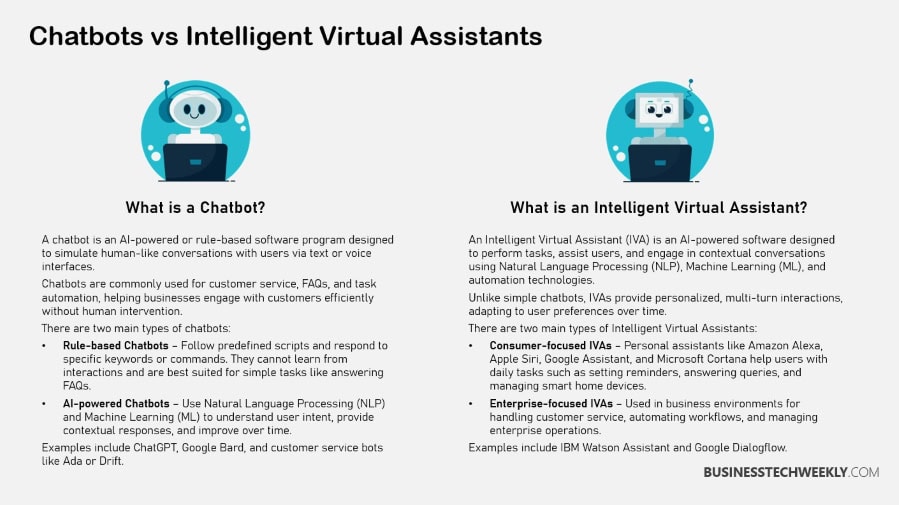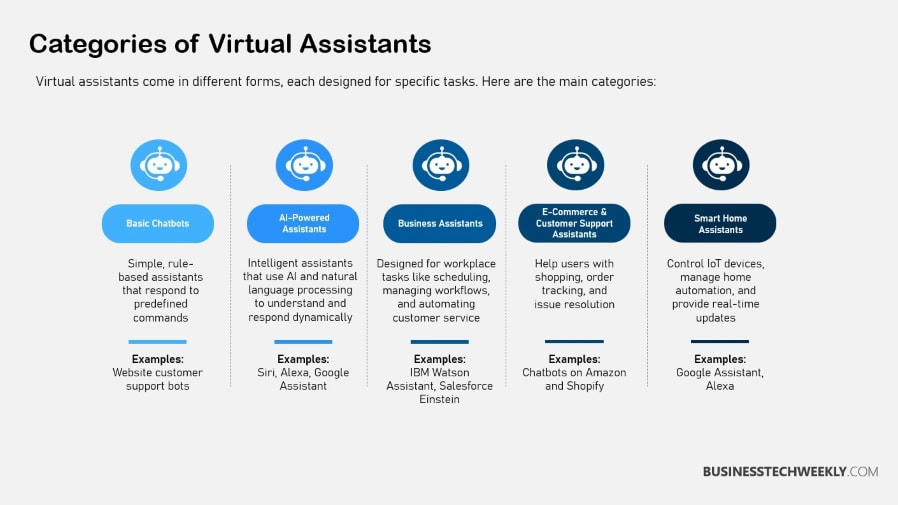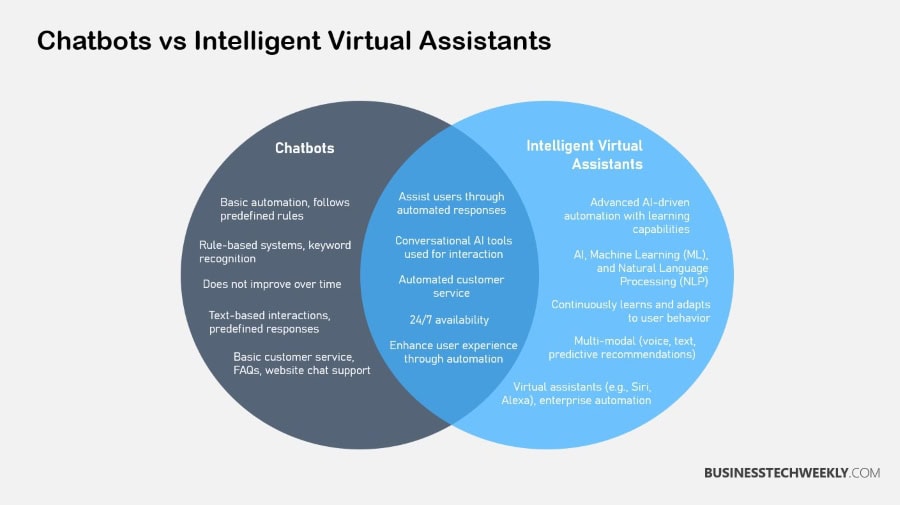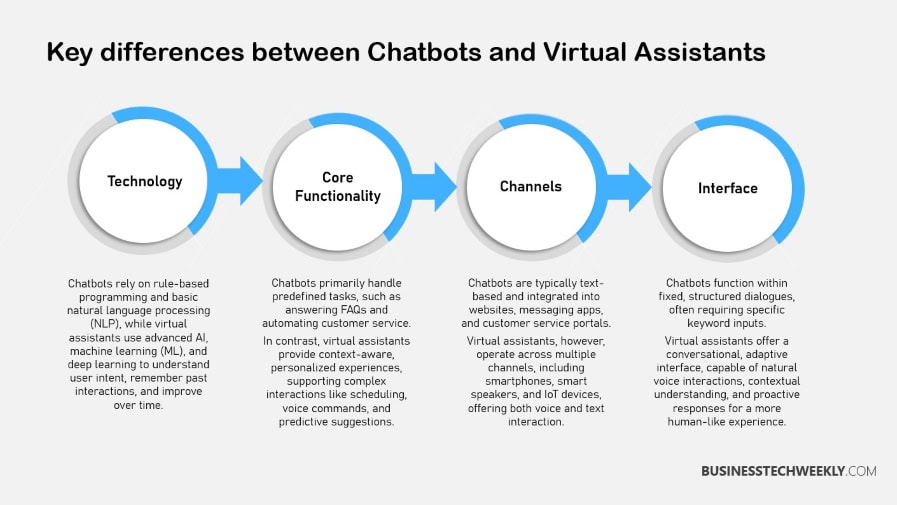Chatbots vs Virtual Assistants: Which is Better?

On this page:
Chatbots vs Virtual Assistants
What Are Chatbots?
Chatbots are virtual assistants that interact with potential customers using automated conversations.
They’re commonly used in customer service, fielding FAQs or assisting with orders.
So think of them more as tireless workhorses answering the repetitive FAQs and getting people the immediate, on-demand information they need.
You may encounter them on a website or through a messaging app, making them extremely accessible.
They are very task-oriented, making sure users receive immediate assistance exactly where they require support.
Only 24% of consumers currently trust chatbots for customer service, suggesting there is significant opportunity for improving consumer trust.
RELATED: How Chatbots can benefit your business
What Are Virtual Assistants?
Chatbots, on the other hand, virtual assistants, they’re a little bit more like your digital Alfred to your Bruce Wayne, right?
They can book appointments for you, filter your inbox, and keep you on top of deadlines.
They’re the new office must-have, like a personal assistant without the cost of a corner office.
Popular examples such as Amazon Alexa and Google Assistant illustrate how pervasive they have grown.
These AI virtual assistants are very intelligent, capable of understanding contextually rich, human-like dialogue and providing relevant, tailored responses.
They leverage cutting-edge technology including NLP and NLU to deeply understand what you’re trying to communicate.
The best part is they don’t sleep, learning from each interaction to make themselves smarter and more helpful every day.

Virtual Assistant Chatbots
Virtual assistant chatbots combine the two. They simplify communication by pairing fast, botlike responses with human virtual assistants’ smarts.
These chatbots are able to address quick tasks as well as deeper conversations, thus becoming more valuable utility tools for users.
By training on actual conversations and human-agent discussions, they are always getting better, delivering trustworthy assistance 24/7.
This combination of features makes them ideally suited for users who require both fast answers as well as in-depth assistance.
Chatbots vs Virtual Assistants: Understanding the Key Differences
1. Technology Utilized
Chatbots largely use rule-based logic, which is typically built to answer FAQs or deliver simple customer service.
These can be further divided into rule-based, intellectually independent, or contextual, providing different levels of complexity.
Virtual assistants, on the other hand, utilize NLU to understand the intent behind a user’s command.
They depend on sophisticated AI and machine learning to execute complex tasks fluidly across different domains.
2. Levels of Intelligence
Traditional chatbots are rule-based, sticking to a script and incapable of learning.
Unlike older chatbots, more sophisticated AI chatbots have the ability to learn from interactions over time.
Virtual assistants use emotional intelligence to better recognize user needs and preferences.
As a result of their ongoing education, they are able to hold sophisticated, multi-issue, multi-topic conversations more efficiently.
RELATED: The Pros and Cons of Chatbots for Online Customer Service
3. Functionality Explained
Chatbots are great in specific industries like e-commerce, where they provide personalized customer support.
Virtual assistants provide flexible solutions to perform multiple complex tasks.
Accessibility will be the most important aspect in deployment, as we see chatbots flourish across social media platforms to provide a more interactive experience.
5. Interface Variations
Chatbots typically interact with users via conversational user interfaces (CUIs) that facilitate text-based exchanges.
Conversely, virtual assistants operate by voice command interface, offering a completely hands-free experience.
The ability of virtual assistants to operate without an interface adds to user convenience.
Comparing Chatbots vs. Intelligent Virtual Assistants (IVAs)
Feature |
Chatbots |
Intelligent Virtual Assistants (IVAs) |
Definition |
Rule-based conversational tools that follow predefined scripts. | AI-powered assistants that use natural language understanding (NLU) and machine learning (ML) to provide intelligent responses. |
Technology Used |
Basic rule-based algorithms, decision trees. | AI, machine learning, NLP, deep learning, and contextual understanding. |
Conversational Ability |
Limited to predefined scripts; struggles with complex queries. | Can engage in human-like conversations, understand intent, and learn from interactions. |
Personalization |
Minimal personalization; offers generic responses. | Learns user preferences and provides personalized interactions. |
Context Awareness |
Lacks context awareness; handles one query at a time. | Remembers past interactions, understands context, and provides relevant responses. |
Learning Capability |
Does not improve over time; requires manual updates. | Continuously learns from interactions and improves responses. |
Integration |
Basic integration with websites and apps. | Integrates with multiple systems (CRM, databases, IoT devices, etc.). |
Use Cases |
FAQs, customer support, appointment scheduling. | Virtual assistants, voice-based assistants, automation of complex workflows. |
Interaction Mode |
Primarily text-based. | Supports text, voice, and even visual inputs. |
Decision-Making |
Follows pre-set rules; no independent decision-making. | Uses AI-driven decision-making for more sophisticated responses. |
Examples |
Rule-based customer service bots, website chat widgets. | Siri, Alexa, Google Assistant, IBM Watson Assistant. |
User Experience |
Can feel robotic and repetitive. | Provides a more natural, engaging, and intuitive experience. |
Cost & Implementation |
Generally lower cost and easier to implement. | More expensive due to advanced AI capabilities but provides higher ROI. |
Best For |
Basic customer service automation, lead generation. | Complex problem-solving, personalized user engagement, advanced automation. |

Benefits of Chatbots and Virtual Assistants
Advantages of Using Chatbots
Chatbots really light up when you need to answer a lot of customers, all at once.
They’re your 24/7 employee of the month, every month. Businesses love the way chatbots deliver 24/7 support with no human intervention required for simple inquiries.
This efficiency leads to significant cost savings while increasing customer satisfaction by delivering solutions at the peak of demand.
In addition, chatbots automate workflows seamlessly, handling common tasks and inquiries and freeing up your staff’s time and resources for more valuable work.
They further improve brand presence by creating a consistent and engaging customer interaction that increases customer trust and loyalty.
Benefits of Virtual Assistants
Whatever the future holds, one thing’s for sure—virtual assistants are a game changer in productivity.
They reduce the burden of mundane tasks, enabling users to spend more time on complex, creative, and strategic work.
They help bring you a healthier work-life balance too. Think of them as your virtual assistant.
They will help you plan your day, remind you of things, and even offer personalized recommendations that fit your schedule.
Because of their capacity to comprehend and produce language in more than 135 dialects, they are worth their weight in gold for worldwide organizations.
Virtual assistants are the front end.
Virtual assistants directly interact with IoT devices.
This functionality simplifies management of smart home systems and devices, increasing convenience and efficiency.
RELATED: Why use Chatbots? 5 ways Chatbots can help deliver Business Success
Combined Benefits
Combined, chatbots and virtual assistants enhance customer engagement and increasing operational efficiency.
They provide a smooth integration across current systems, allowing for data consistency and operational effectiveness.
Through the understanding of customer interactions, they provide an intelligence that improves customer engagement.
These technologies help ease the burden on human agents.
Protect sensitive information. Not only do they provide robust data security, but it’s absolutely critical when dealing with sensitive information.

Chatbots vs Virtual Assistants: Choosing the Right One for your Needs
Identifying Business Needs
When deciding between chatbots and virtual assistants, it’s essential to pinpoint your business needs.
Start by evaluating how each option can align with your organizational goals.
If customer engagement is your main focus, chatbots might fit the bill.
They are particularly effective for businesses wanting to offer swift support, such as answering FAQs or order processing.
If enhancing personal productivity is crucial, virtual assistants, with their ability to manage tasks and organize schedules, offer a more personalized experience.
Understanding customer interaction patterns can guide you in choosing the technology that fits best.
Identify operational tasks needing automation or assistance to ensure clarity in your choice.
Use Cases for Chatbots
Chatbots really succeed in niche situations. They are responsible for customer service inquiries, tracking orders, and answering frequently asked questions in a flash.
Industries such as e-commerce and travel are reaping the rewards thanks to their lead generation and sales support capabilities.
By providing quick answers, chatbots boost user satisfaction, making them an essential asset for any business focused on a customer-first strategy.
Use Cases for Virtual Assistants
Virtual assistants excel in various tasks, including managing appointments, sending reminders, and organizing daily tasks.
In personal settings, they help manage smart home devices and plan daily activities.
Professionally, they help take care of administrative tasks and project management.
This makes them a perfect fit with platforms such as Watson and Dialogflow.
Checklist for Selecting the Right Option
Consider these criteria: user interaction type, task complexity, and integration needs.
To get the most out of whichever option you choose, align your decision with your business objectives and user needs.

Key Points to Note
Now you are in the know on chatbots vs virtual assistants.
Both have their advantages, revolutionizing the way we use technology on a daily basis.
- Chatbots and virtual assistants serve different purposes. Chatbots enhance customer interactions, while virtual assistants manage personal tasks to boost productivity.
- Chatbots offer immediate assistance right on your website and popular messaging applications. Virtual assistants power smart devices and mobile apps.
- The intelligence levels are all over the place. Second, chatbots have very little capacity to learn, while virtual assistants learn, grow, and evolve with user needs over time.
- With advantages such as 24/7 availability and cost-effectiveness, chatbots are well-suited for managing repetitive customer questions.
- Virtual assistants help enhance work-life balance by efficiently managing schedules, emails, and reminders, providing personalized assistance to users.
- When choosing between chatbots and virtual assistants, evaluate your business needs, desired user interaction types, and integration capabilities with existing systems.

